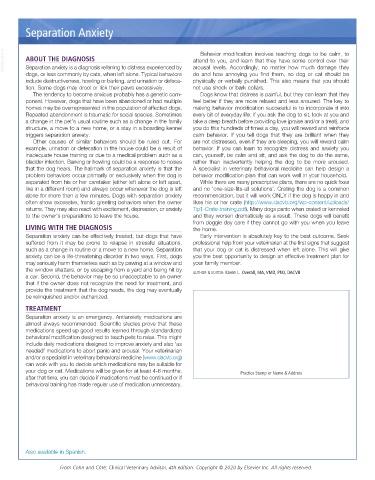Page 3127 - Cote clinical veterinary advisor dogs and cats 4th
P. 3127
Separation Anxiety
VetBooks.ir ABOUT THE DIAGNOSIS attend to you, and learn that they have some control over their
Behavior modification involves teaching dogs to be calm, to
arousal levels. Accordingly, no matter how much damage they
Separation anxiety is a diagnosis referring to distress experienced by
dogs, or less commonly by cats, when left alone. Typical behaviors do and how annoying you find them, no dog or cat should be
include destructiveness, howling or barking, and urination or defeca- physically or verbally punished. This also means that you should
tion. Some dogs may drool or lick their paws excessively. not use shock or bark collars.
The tendency to become anxious probably has a genetic com- Dogs know that distress is painful, but they can learn that they
ponent. However, dogs that have been abandoned or had multiple feel better if they are more relaxed and less aroused. The key to
homes may be overrepresented in the population of affected dogs. making behavior modification successful is to incorporate it into
Repeated abandonment is traumatic for social species. Sometimes every bit of everyday life. If you ask the dog to sit, look at you and
a change in the pet’s usual routine such as a change in the family take a deep breath before providing love (praise and/or a treat), and
structure, a move to a new home, or a stay in a boarding kennel you do this hundreds of times a day, you will reward and reinforce
triggers separation anxiety. calm behavior. If you tell dogs that they are brilliant when they
Other causes of similar behaviors should be ruled out. For are not distressed, even if they are sleeping, you will reward calm
example, urination or defecation in the house could be a result of behavior. If you can learn to recognize distress and anxiety you
inadequate house training or due to a medical problem such as a can, yourself, be calm and sit, and ask the dog to do the same,
bladder infection. Barking or howling could be a response to noises rather than inadvertently helping the dog to be more aroused.
that the dog hears. The hallmark of separation anxiety is that the A specialist in veterinary behavioral medicine can help design a
problem behaviors occur primarily or exclusively when the dog is behavior modification plan that can work well in your household.
separated from his or her caretaker (either left alone or left apart, While there are many prescriptive plans, there are no quick fixes
like in a different room) and always occur whenever the dog is left and no ‘one-size-fits-all solutions’. Crating the dog is a common
alone for more than a few minutes. Dogs with separation anxiety recommendation, but it will work ONLY if the dog is happy in and
often show excessive, frantic greeting behaviors when the owner likes his or her crate (http://www.dacvb.org/wp-content/uploads/
returns. They may also react with excitement, depression, or anxiety Tip1-Crate-training.pdf). Many dogs panic when crated or kenneled
to the owner’s preparations to leave the house. and they worsen dramatically as a result. These dogs will benefit
from doggie day care if they cannot go with you when you leave
LIVING WITH THE DIAGNOSIS the home.
Separation anxiety can be effectively treated, but dogs that have Early intervention is absolutely key to the best outcome. Seek
suffered from it may be prone to relapse in stressful situations, professional help from your veterinarian at the first signs that suggest
such as a change in routine or a move to a new home. Separation that your dog or cat is distressed when left alone. This will give
anxiety can be a life-threatening disorder in two ways. First, dogs you the best opportunity to design an effective treatment plan for
may seriously harm themselves such as by pawing at a window and your family member.
the window shatters, or by escaping from a yard and being hit by
a car. Second, the behavior may be so unacceptable to an owner AUTHOR & EDITOR: Karen L. Overall, MA, VMD, PhD, DACVB
that if the owner does not recognize the need for treatment, and
provide the treatment that the dog needs, the dog may eventually
be relinquished and/or euthanized.
TREATMENT
Separation anxiety is an emergency. Antianxiety medications are
almost always recommended. Scientific studies prove that these
medications speed up good results learned through standardized
behavioral modification designed to teach pets to relax. This might
include daily medications designed to improve anxiety and also ‘as
needed’ medications to abort panic and arousal. Your veterinarian
and/or a specialist in veterinary behavioral medicine (www.dacvb.org)
can work with you to decide which medications may be suitable for
your dog or cat. Medications will be given for at least 4-6 months; Practice Stamp or Name & Address
after that time, you can decide if medications must be continued or if
behavioral training has made regular use of medication unnecessary.
Also available in Spanish.
From Cohn and Côté: Clinical Veterinary Advisor, 4th edition. Copyright © 2020 by Elsevier Inc. All rights reserved.

